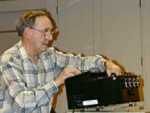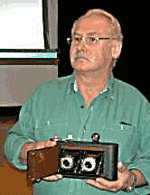Stan White presents "A Sampling of Canadian Stereo Photographers"
THE SHOW. Every fall we host a stereo night. This year the feature presentation was
a show put together by Stan White to celebrate Canadian stereo
photographers. The show was presented this summer at a meeting of the PSA
Stereo division held in Mississauga. The slides cover the work of 15
photographers, plus a selection from the collection of Mr.. S. Fox taken
by an unknown photographer.
The featured photographers, some of whom were present at the showing, are Simon Bell (Toronto), Alldyn Clark (Bracebridge), Nick Dobish (Alberta), the late Hubert Dell (Toronto) Rolf Eipper (Western Canada), Bruce Hodgson, Eileen Hodgson, Josh Kaell, Thomasz Przystupa, Richard Reidel, William Tindale (Hamilton), Dale Walsh (Montreal), Stan White (St. George, Ontario), Robert Wilson (Toronto), and Mike Yatsula (Belleville). If you want further information about these artists, contact Stan White.
The sample images were taken with a Nikon Coolpix 900s directly off the screen. As a result the image is double (time permitting, a copy of a single image would have been better). Clicking on any of the thumbnails at the right will bring up a larger version of the photo.
THE PROJECTOR. The slides were shown using Stan's personal Brackett stereo projector. This custom made machine has a built-in dissolve for smooth transitions. The slides must be loaded manually, however. Stan explained that the Brackett projectors are no longer available since Mr. Brackett has stopped making them (Stan's projector is a very early one). The Brackett is a very heavy, well made projector which uses Kodak commercial 35mm projector lenses and components. An alternative stereo projector is made in Germany, but it is a single stereo. To match the Brackett, you have to purchase two projectors and a dissolve unit.
SHOW AND TELL. A handful of stereo show and tell items were discussed after the show. Sam Schlifer, Manual Nunes, and Walter Shean brought images.
Sam Schlifer had a couple of the traditional card mounted images--except they were ones he took and printed himself.
Manual Nunes showed a modern day, small lenticular image made by a local photographer. The screen was so fine you didn't notice it at all. The image was mounted in a modern wooden frame. Manual purchased two of the images at our October fair.
Walter Shean had a few mid century advertising and Hollywood movie promotional lenticular images. They were impressive shots, which he showed with a light table mounted on end. The example I show here was quite appealing... The actors looked almost plastic with the make-up and the slightly exaggerated 3D effect. There were some black marks on the image likely from the black tape used to hold the image and glass cover together.
Robert Wilson showed an unusual stereo image which consisted of the two images printed on either side of a transparent polarized film. The image was mounted in a hinged folder. Using the standard polarizing glasses, the image jumped off the film in 3D.
Robert Wilson also brought what appeared to be a stereo enlarger. While well made, it had the obvious appearance of a home-made device. A careful inspection suggested the instrument was a copier (1:1) rather than an enlarger since there was no means to change the magnification (lens -- negative distance). The paper-holder could be moved to focus. The lenses were made by Kodak, and a metal two-setting Waterhouse stop was added behind them to stop down. After some discussion it was decided that the device was used to make a number of copies of each negative. Cutting the images apart and transposing them would permit prints to be made with the two images correctly positioned for viewing.
Sid Sobel showed a Rollei stereo bar in its original paper box. This device allowed the photographer to mount his Rollei level on a tripod to take still stereos. The camera was moved to one side of the bar for one shot and the other side for the second shot. A number of other cameras had similar stereo bars. Sid noted the virtue of the built-in level which ensured the images would be level for easy viewing.
Ed Warner showed his talents as a craftsman with an unusual hand made stereo camera. The works consisted of two small Agfa bellows cameras mounted inside an old Kodak folder. Ed added such frills as a ratchet film winder which moved the film along without recourse to the usual "number in the red window" once the film's starting position is set.
by Robert Carter
Photos

We had to duck for this one...

Logo on the Brackett projector

Front view of the Brackett projector

Lenticular screen movie promotion







